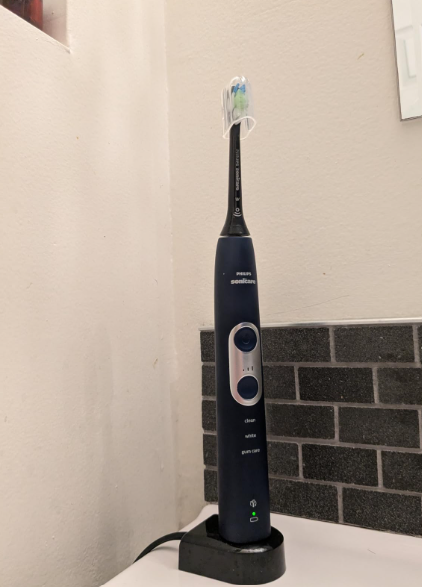
Introduction to the Sonicare Series 6100
The Philips Sonicare Series 6100 is an advanced electric toothbrush that combines an attractive design, premium features, and effective cleaning performance. In this in-depth review, we’ll explore its key features, performance, advantages, potential drawbacks, and how it compares with other models on the market.
- Gentle whitening and efficient oral care: Philips Sonicare ProtectiveClean 6100 improves gum health in only 2 weeks and …
- Smart brushing: a pressure sensor that automatically detects pressure you apply, warns you, and reduces the toothbrush v…
- Personalized oral care: Clean mode for superior cleaning, White mode to remove surface stains, and Gum Care mode to gent…
Design and Ergonomics of the Handle
Buttons, Finish, and Grip
The Series 6100 features a clean design without textured surfaces that might trap dirt. Instead, its matte finish provides a surprisingly non-slip grip even when wet. It includes two physical buttons: one for power and another for selecting modes and intensities. Although it doesn’t follow the “seamless” design of premium models like the Prestige 9900, its configuration is very user-friendly and arguably more reliable in terms of durability.

Balance and Materials
The handle feels balanced and comfortable to hold. Its plastic construction makes it less prone to visible marks compared with metallic models like the Laifen Wave. It’s slightly thicker in the palm compared with the Series 3100, but this is offset by a battery that lasts significantly longer—up to 48 days per charge. Both cleaning modes run for 2 minutes, guided by a 20-second pacer that divides the mouth into sextants for more structured brushing.

Cleaning Modes and Customization
Six Adjustable Configurations

Unlike entry-level models, the Series 6100 offers six possible settings: two cleaning modes (Clean and Sensitive), each with three intensity levels (low, medium, and high). LEDs on the handle clearly indicate the selected mode and intensity, enhancing usability compared to models such as the Series 5300.
Advanced Pressure Sensor

The built-in pressure sensor vibrates and alters the brush’s sound if you apply too much force, helping protect gums and enamel. It also features a purple LED at the base of the handle that lights up when excessive pressure is detected. This combination of tactile, audible, and visual signals makes it particularly helpful for users with visual impairments, unlike some Oral-B models that rely solely on LED indicators.
Usability and Brushing Experience
Timer and Sound Indicators

The Series 6100 automatically switches off at the end of each brushing cycle and remembers the last settings used when powered back on. Its hum registers at around 63 dB, making it gentler on the ears compared to the harsher, mechanical sound of some Oral-B models.
Practical Indicators

Additional LEDs include a three-level battery indicator and a brush head replacement reminder, part of the BrushSync system. The built-in RFID chip tracks head usage and, once the recommended lifespan is reached, the handle vibrates and lights up to signal a replacement. While this adds to electronic waste, it’s undeniably practical for users who often forget when they last replaced a head.
Connectivity, Sustainability, and Ethical Considerations

No Bluetooth—Is It a Loss?
Unlike the Series 6500 or 7100, this model doesn’t include Bluetooth connectivity. For many users, this isn’t a major drawback, as the brush already ensures a thorough clean without app integration. However, models like the DiamondClean or Prestige provide real-time feedback on missed areas, which could be valuable for perfectionists aiming to refine their brushing technique.
Environmental Commitment
Philips has replaced plastic packaging with paper sleeves and adapted the charging stand to use a USB-A connector instead of a standard power adapter. Unfortunately, the adapter itself is not included in the box. A questionable detail is that the European packaging states “Made in the Netherlands,” while the charging base itself is labeled “Made in China,” which some may view as misleading.
Price, Comparisons, and Final Recommendations

Value for Money
The Sonicare Series 6100 sits firmly in the premium segment, with retail prices in the US often exceeding $130. However, it can sometimes be found for under $100. Replacement brush heads cost about $7 each, making ownership more expensive compared to alternatives like the Oral-B Pro 3, which also delivers excellent cleaning performance at a lower cost.
Justifying the Price
The Series 6100’s value lies in features such as the multi-signal pressure sensor (vibration, sound, and light), intelligent reminders, intuitive design, and extended battery life. Philips has also included small touches like vibrations and beeps when placing it on the charging stand, which are often absent in competing models.
Who Is It Best For?
- Users seeking effective, straightforward cleaning without relying on mobile apps.
- Individuals with sensitive gums or enamel, thanks to adjustable intensity and pressure protection.
- Those who prioritize long battery life and a low-maintenance design.
Possible Limitations
- Higher price point.
- Lack of Bluetooth connectivity and real-time tracking.
- Extra electronic waste due to RFID-enabled head replacement reminders.
Conclusion

The Philips Sonicare Series 6100 strikes a balance between functionality, ergonomics, and durability. It delivers a comprehensive brushing experience without complicating things with unnecessary digital features. While its price places it in the high-end category, features like its long-lasting battery, advanced pressure sensor with multiple alerts, and user-friendly design can justify the investment for those who value quality and efficiency in oral care.

